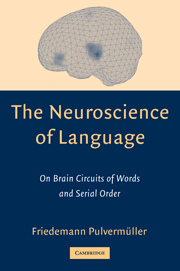Book contents
- Frontmatter
- Contents
- Preface
- The Neuroscience of Language
- 1 A Guide to the Book
- 2 Neuronal Structure and Function
- 3 From Classic Aphasia Research to Modern Neuroimaging
- 4 Words in the Brain
- Excursus E1 Explaining Neuropsychological Double Dissociations
- 5 Regulation, Overlap, and Web Tails
- 6 Neural Algorithms and Neural Networks
- 7 Basic Syntax
- 8 Synfire Chains as the Basis of Serial Order in the Brain
- 9 Sequence Detectors
- 10 Neuronal Grammar
- 11 Neuronal Grammar and Algorithms
- Excursus E2 Basic Bits of Neuronal Grammar
- Excursus E3 A Web Response to a Sentence
- 12 Refining Neuronal Grammar
- Excursus E4 Multiple Reverberation for Resolving Lexical Ambiguity
- Excursus E5 Multiple Reverberations and Multiple Center Embeddings
- 13 Neurophysiology of Syntax
- 14 Linguistics and the Brain
- References
- Abbreviations
- Author Index
- Subject Index
8 - Synfire Chains as the Basis of Serial Order in the Brain
Published online by Cambridge University Press: 15 December 2009
- Frontmatter
- Contents
- Preface
- The Neuroscience of Language
- 1 A Guide to the Book
- 2 Neuronal Structure and Function
- 3 From Classic Aphasia Research to Modern Neuroimaging
- 4 Words in the Brain
- Excursus E1 Explaining Neuropsychological Double Dissociations
- 5 Regulation, Overlap, and Web Tails
- 6 Neural Algorithms and Neural Networks
- 7 Basic Syntax
- 8 Synfire Chains as the Basis of Serial Order in the Brain
- 9 Sequence Detectors
- 10 Neuronal Grammar
- 11 Neuronal Grammar and Algorithms
- Excursus E2 Basic Bits of Neuronal Grammar
- Excursus E3 A Web Response to a Sentence
- 12 Refining Neuronal Grammar
- Excursus E4 Multiple Reverberation for Resolving Lexical Ambiguity
- Excursus E5 Multiple Reverberations and Multiple Center Embeddings
- 13 Neurophysiology of Syntax
- 14 Linguistics and the Brain
- References
- Abbreviations
- Author Index
- Subject Index
Summary
The putative brain mechanisms of word processing are highlighted in earlier chapters; however, mechanisms of serial order have until now been addressed only sporadically in terms of neurons. This chapter now focuses on neuroscientific questionsabout serial order. Serial-order mechanisms relevant for language processing are being specified in great detail by linguistic theories, but these are not easily converted into neuron mechanisms. Suchconversion of linguistic theory into neuroscientific models is possible by replacing rules and the operations they determine by artificialneurons and their dynamics (see Schnelle, 1996b). However, this chapter and Chapter 9 take a different approach. First, the question of which serial-order mechanisms are suggested by neurophysiological research is considered. The mechanisms inferred from neuroscientific data are then used as a basis of a neuronal model of syntax.
How may rules governing serial order of language elements be realized in the brain? This question may be asked with regard to the level of words and morphemes, the smallest language units that carry meaning, the meaning atoms, so to speak. A similar question may also be asked at the level of phonemes, languagesounds distinguishing between morphemes or words: How are phoneme sequences stored and processed neuronally? The followingparagraphs review brain mechanisms that could be relevant for establishing serial order of language units.
Neurophysiological Evidence and Neuronal Models
A sequence AB of events can be represented by two directly connected neuronal units: one corresponding to event A and the other to event B. If the respective neuronal units are referred to by Greekletters, α and β, the sequence of events could be realized as α, β, and, in addition, a direct connection from α to β.
- Type
- Chapter
- Information
- The Neuroscience of LanguageOn Brain Circuits of Words and Serial Order, pp. 147 - 158Publisher: Cambridge University PressPrint publication year: 2003



